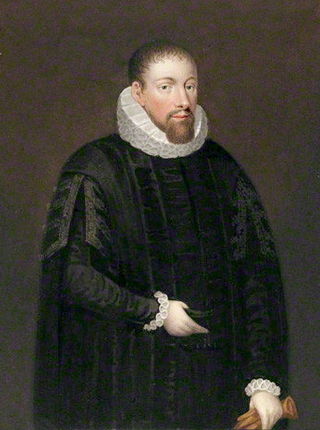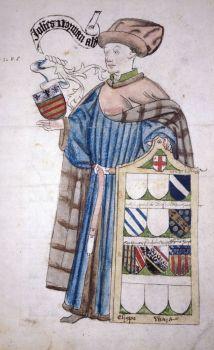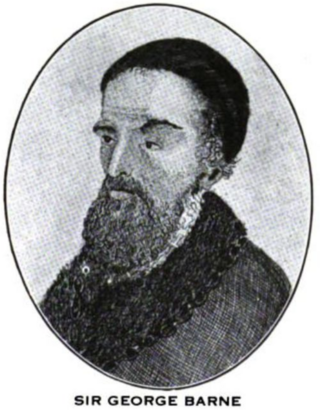
The Lord Mayor of London is the mayor of the City of London, England, and the leader of the City of London Corporation. Within the City, the Lord Mayor is accorded precedence over all individuals except the sovereign and retains various traditional powers, rights, and privileges, including the title and style The Right Honourable Lord Mayor of London.

The Lord Mayor of Dublin is the honorary title of the chairperson of Dublin City Council which is the local government body for the city of Dublin, the capital of Ireland. The incumbent, since June 2023, is councillor Daithí de Róiste. The office holder is elected annually by the members of the Council.
Sir Maurice Abbot (Morris) (1565–1642) was an English merchant, Governor of the East India Company (1624–1638), and a politician who sat in the House of Commons between 1621 and 1626. He was Lord Mayor of London in 1638.

The Worshipful Company of Fishmongers is one of the 111 Livery Companies of the City of London, being an incorporated guild of sellers of fish and seafood in the City. The Company ranks fourth in the order of precedence of City Livery Companies, thereby making it one of the Great Twelve City Livery Companies.

The First Sea Lord and Chief of the Naval Staff (1SL/CNS) is a statutory position in the British Armed Forces usually held by a four star admiral. As the highest-ranking officer to serve in the Royal Navy, the chief is the principal military advisor on matters pertaining to the navy and a deputy to the Secretary of State for Defence. In a separate capacity, the CNS is a member of the Chiefs of Staff Committee and, thereby, a military advisor to the National Security Council, the prime minister and the monarch. The First Sea Lord is typically the highest-ranking officer on active duty of the Royal Navy unless the Chief of the Defence Staff is a naval officer. Admiral Ben Key was appointed First Sea Lord in November 2021.

The Lord Mayor's Show is one of the best-known annual events in London as well as one of the longest-established, dating back to the 13th century. A new lord mayor is appointed every year, and the public parade that takes place as their inauguration ceremony reflects that this was once one of the most prominent offices in England and subsequently the United Kingdom.

Temple Bar was the principal ceremonial entrance to the City of London from the City of Westminster. In the middle ages, London expanded city jurisdiction beyond its walls to gates, called ‘bars’, which were erected across thoroughfares. To the west of the City of London, the bar was located adjacent to the area known as the Temple. Temple Bar was situated on the historic royal ceremonial route from the Tower of London to the Palace of Westminster, the two chief residences of the medieval English monarchs, and from the Palace of Westminster to St Paul's Cathedral. The road east of the bar within the City was Fleet Street, while the road to the west, in Westminster, was The Strand.

Sir Gilbert Heathcote, 1st Baronet was an English merchant and Whig politician who sat in the English and British House of Commons between 1701 and 1733. He also served as the governor of the Bank of England and was Lord Mayor of London in 1711.

Caleb Heathcote served as the 31st Mayor of New York City from 1711 to 1713.
The recorder of London is an ancient legal office in the City of London. The recorder of London is the senior circuit judge at the Central Criminal Court, hearing trials of criminal offences. The recorder is appointed by the Crown on the recommendation of the City of London Corporation with the concurrence of the Lord Chancellor. The recorder's deputy is the Common Serjeant of London, appointed by the Crown on the recommendation of the Lord Chancellor. The recorder of London is, since 14 April 2020, Mark Lucraft.
There have been two baronetcies created for people with the surname Heathcote, both in the Baronetage of Great Britain and both created in 1733. The holders of the first creation were later elevated to the peerage as Baron Aveland and Earl of Ancaster, which titles are now extinct. However, both baronetcies are extant as of 2008.

Sir Robert Broke SL was an English judge, politician and legal writer. Although a landowner in rural Shropshire, he made his fortune through more than 20 years' service to the City of London. MP for the City in five parliaments, he served as Speaker of the House of Commons in 1554. He is celebrated as the author of one of the Books of authority. A prominent religious conservative, he founded a notable recusant dynasty. His surname is also rendered Brooke, and occasionally Brook, which are, for modern readers, better indicators of pronunciation.
Sir Nicholas Brembre was a wealthy magnate and a chief ally of King Richard II in 14th-century England. He was Lord Mayor of London in 1377, and again from 1384–5,6. Named a "worthie and puissant man of the city" by Richard Grafton, he became a citizen and grocer of London, and in 1372-3 purchased from the Malmains family the estates of Mereworth, Maplescomb, and West Peckham, in Kent. His ties to Richard ultimately resulted in his downfall, as the anti-Richard Lords Appellant effectively took control of the government and imprisoned, exiled, or executed most of Richard's court. Despite Richard's efforts, Brembre was executed in 1388 for treason at the behest of the Lords Appellant.

John Norman was a 15th-century draper, sheriff, alderman and for a term the Lord Mayor of London. He is known as being the first lord mayor to take a boat to Westminster to pledge his allegiance. Up until that point lord mayors of London had ridden or walked to Westminster in the yearly pageant on Lord Mayor's Day. Such river pageants existed until 1856, and today the lord mayor rides within a state coach during the pageant which is known today as Lord Mayor's Show. John Norman left his name to a song, supposedly created by the watermen who rowed him to Westminster, titled "Row the Boat, Norman".

Sir Martin Bowes was a very prominent and active civic dignitary of Tudor London whose career continued through the reigns of Henry VIII, Edward VI, Mary I and Elizabeth I. Born into the citizenry of York, Bowes was apprenticed in London and made his career at the Royal Mint, as a master-worker and under-treasurer, and personally implemented the debasement of English currency which became a fiscal imperative in the later reign of Henry.
Sir Humphrey Edwin (1642–1707) was an English merchant and Lord Mayor of London for the year 1697 to 1698.

Sir Thomas Pilkington was an English merchant and Whig politician who served as the Lord Mayor of London in 1689.

The Lord Mayor of London's State Coach is, along with the King's Gold State Coach and the Speaker's State Coach, one of the three great State Coaches of the United Kingdom. Unlike the other two the Lord Mayor's Coach is used annually at the Lord Mayor's Show, and as such it is deemed to be the oldest ceremonial vehicle in regular use in the world.

Sir George Barne was an English businessman in the City of London who was active in developing new trading links with Russia, West Africa and North America, far outside what had been traditional English trading patterns. Created a knight in 1553, he served as Sheriff of London and Lord Mayor of London. He was the father of Sir George Barne and grandfather of Sir William Barne. Nicholas Culverwell was probably a nephew.















